New Zealand, the Land Of The Long White Cloud, needs no introduction. Everybody is aware of its sheer beauty, a beauty brought to a worldwide audience thanks to Peter Jackson’s 2001-2003 Lord of The Rings movie trilogy. Earlier this year I was fortunate enough to spend 6 weeks travelling around this remote, sparsely populated country (with 40 million & counting it has 10 times as many sheep as people) & I present here a photo essay, from the very tip of the North Island to the windswept bottom of the South, showcasing some it’s unparalleled natural beauty & must-see highlights.
This is a wonderful guest post contribution from David M Byrne:
North Island
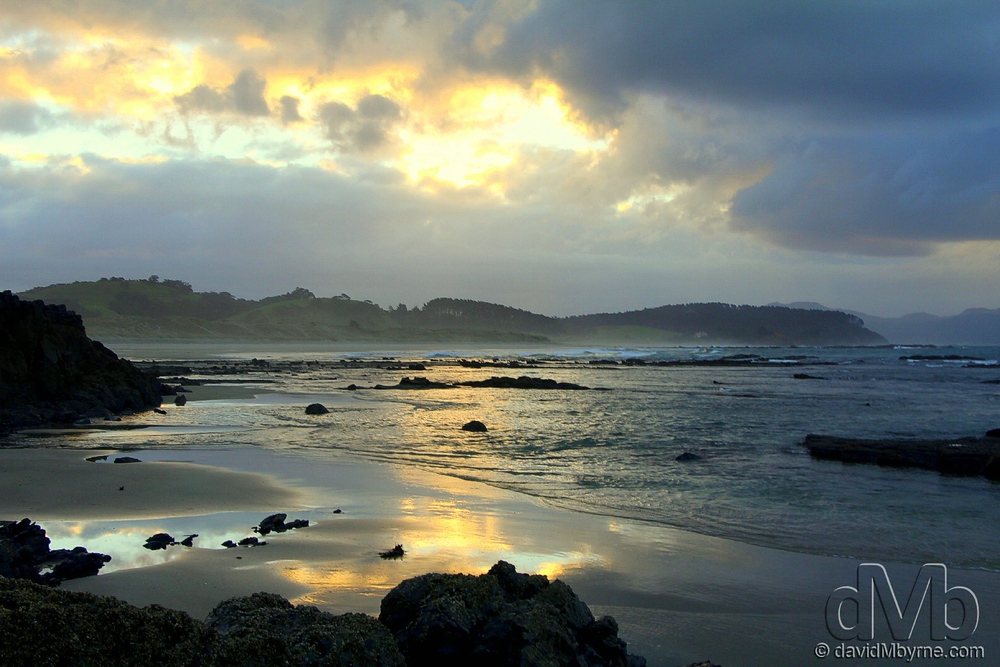
Stunning New Zealand Scenery
- Sunset on a beach at remote Tawharanui Regional Park. April 27th 2012.
Northland is a rugged finger of land stretching for some 400+kms north of Auckland, New Zealand’s largest city (although not it’s capital). Up there it’s all about natural attractions; it’s a sparsely populated area of deserted beaches & breathtakingly beautiful coastal scenery.
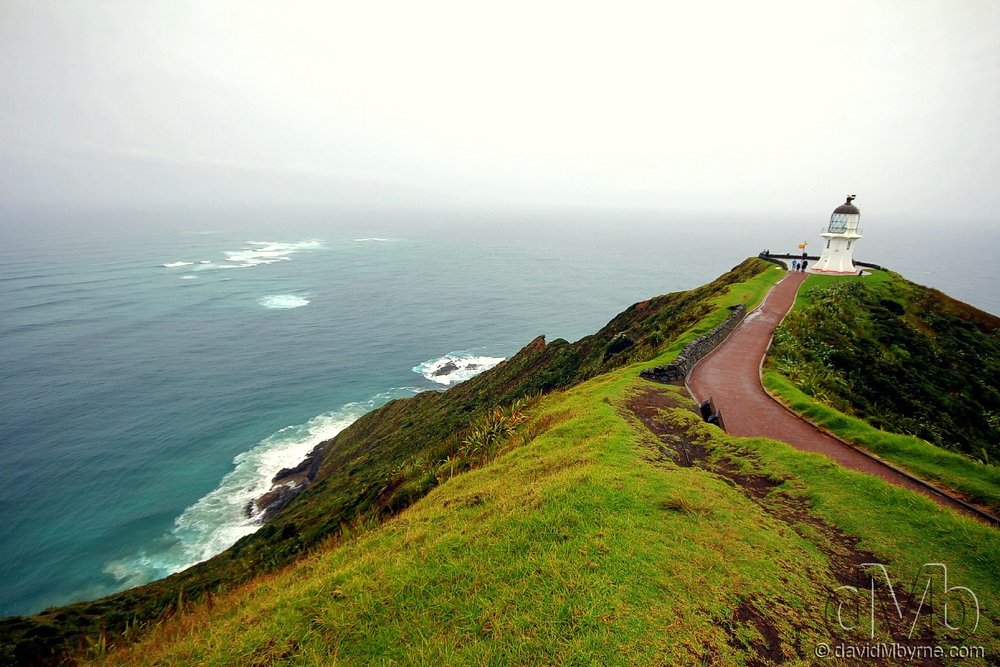
- The end-of-the-world feeling at Cape Reinga. April 30th 2012.
You can’t get much further north than this, Cape Reinga, sitting at the tip of land that forms NZ’s northern extremity. Things get very remote up here & the end-of-the-world feeling one gets looking out over the vast expanse of ocean, with the waters of the Tasman Sea (to the west/left) and Pacific Ocean (to the east/right) breaking together, is hard to portray in pictures.
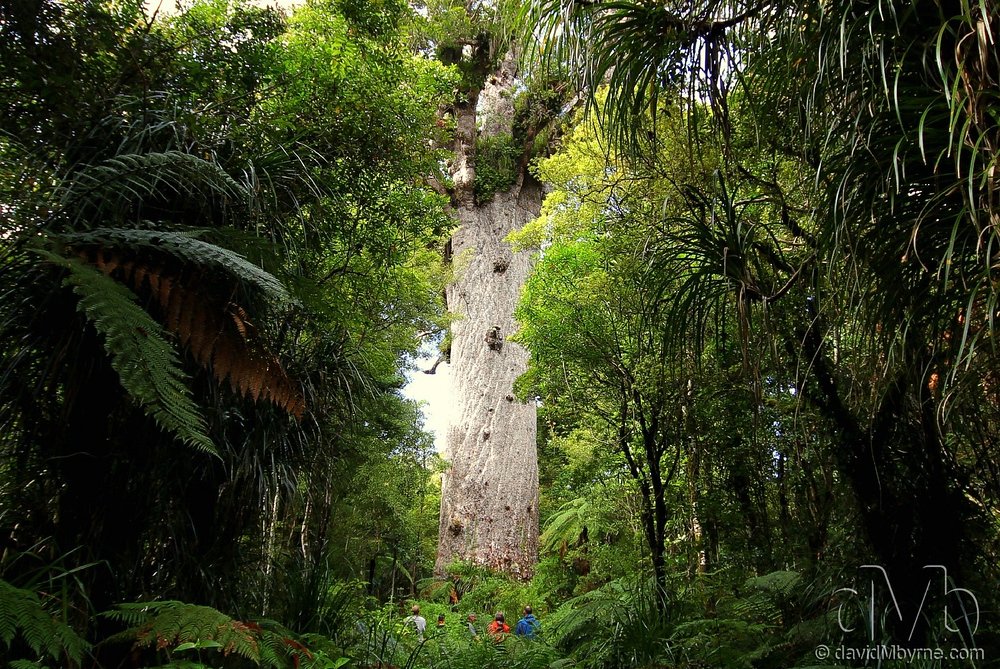
- A giant Kauri tree in Waipoua Kauri Forest, one of the last remaining kauri tree sanctuaries on earth. May 1st 2012.
This is Tane Mahuta who, at 51 metres high, 13.8 metre in girth and with a wood mass of 244.5 cubic metres, is the largest & one of the oldest kauri trees alive. He’s found in the Waipoua Kauri Forest, one of the great natural highlights of Northland’s west coast. Kauri forests were once widespread in the northern part of the country but they diminished with the arrival of the Europeans in the mid-19thcentury. Now only remnants of the once-great forests remain.
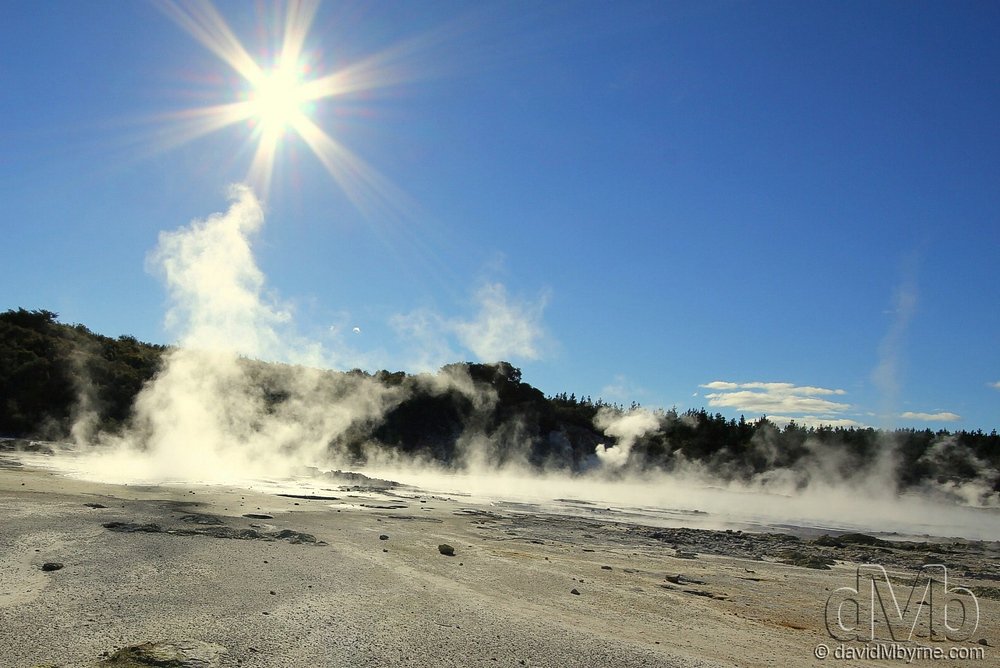
- Geothermal Activity at Steam Hells Gate Geothermal Reserve, Rotorua. May 5th 2012.
Rotorua is the tourist hotbed of the North Island, a geothermal wonderland full of geysers, bubbling hot mud pools & clouds of rotten egg-smelling sulphurous gasses. It sits on the Rotorua caledra, one of several active volcanoes in an area known as the Taupo Volcanic Zone. Hell’s Gate is one of the many $35-entry-fee thermal reserves in the Rotorua vicinity, but the only one owned & operated by a Maori (indigenous New Zealanders) tribe.
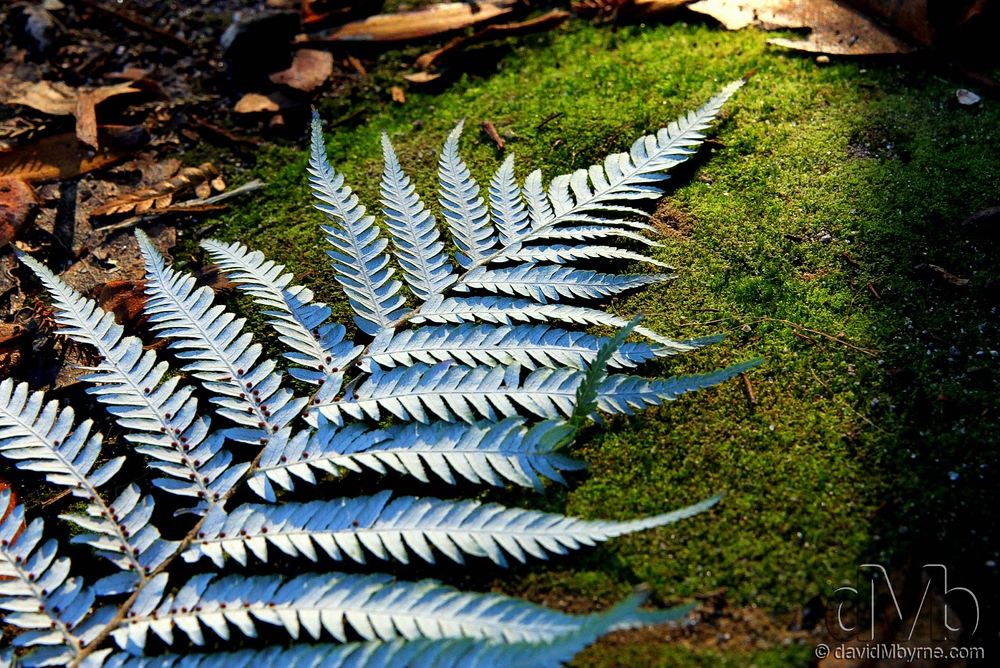
- A Silver Fern, the emblem of New Zealand, rests on an illuminated forest floor on the outskirts of Rotorua. May 5th 2012.
The medium-sized tree fern is endemic to New Zealand & is the symbol commonly associated with the country – it appears on the country’s coat of arms & many New Zealanders get it tattooed on themselves to show their Kiwiness.
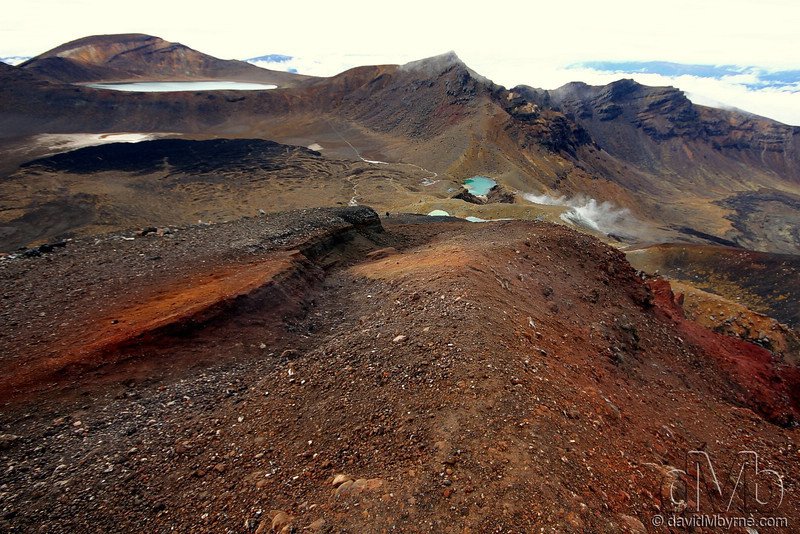
- Volcanic topography in the heart of the Tongariro National Park. May 9th 2012.
The volcanic centre of the North Island is dominated by the Tongariro National Park. Established in 1887 this was New Zealand’s first national park & is probably it’s most famous… & definitely it’s most spectacular. The park is dominated by three peaks, 3 active volcanoes. In winter (the northern hemisphere’s summer) it’s a haven for skiers & in summer it’s a haven for hikers, offering some of the world’s best tramps/hiking, crossing martian-esque terrain of active craters, steaming vents & beautiful coloured sulphur lakes.
South Island
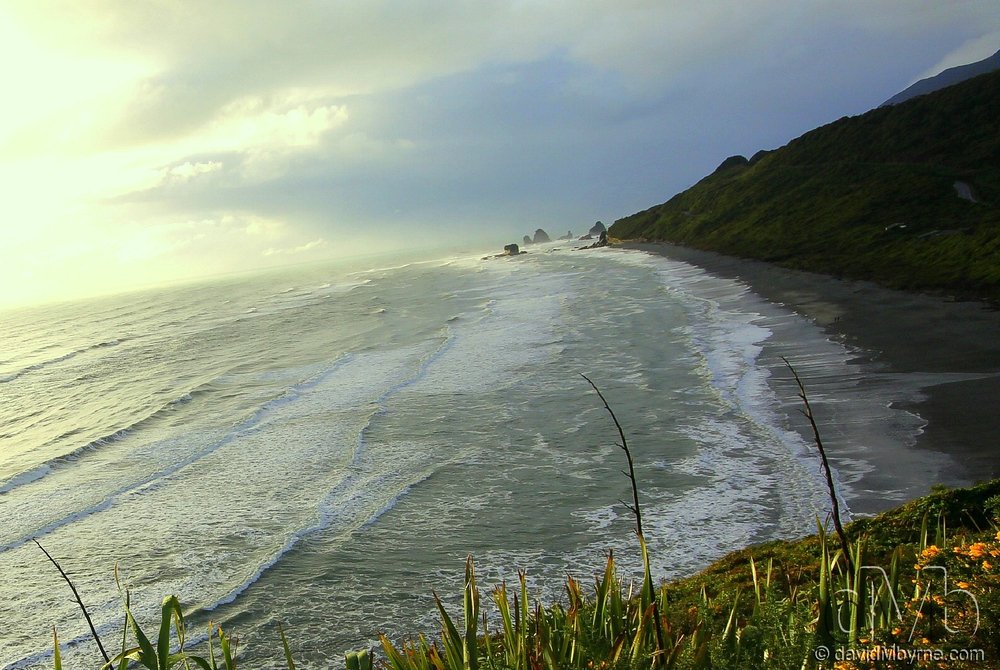
- Late afternoon sunlight off the rain-soaked West Coast. May 17th 2012.
The West Coast of New Zealand’s South Island is one of the more remote and most sparsely populated areas of the country. It’s synonymous with beauty, rugged beauty; wild coastlines, snow-capped mountains & glaciers are its forte.
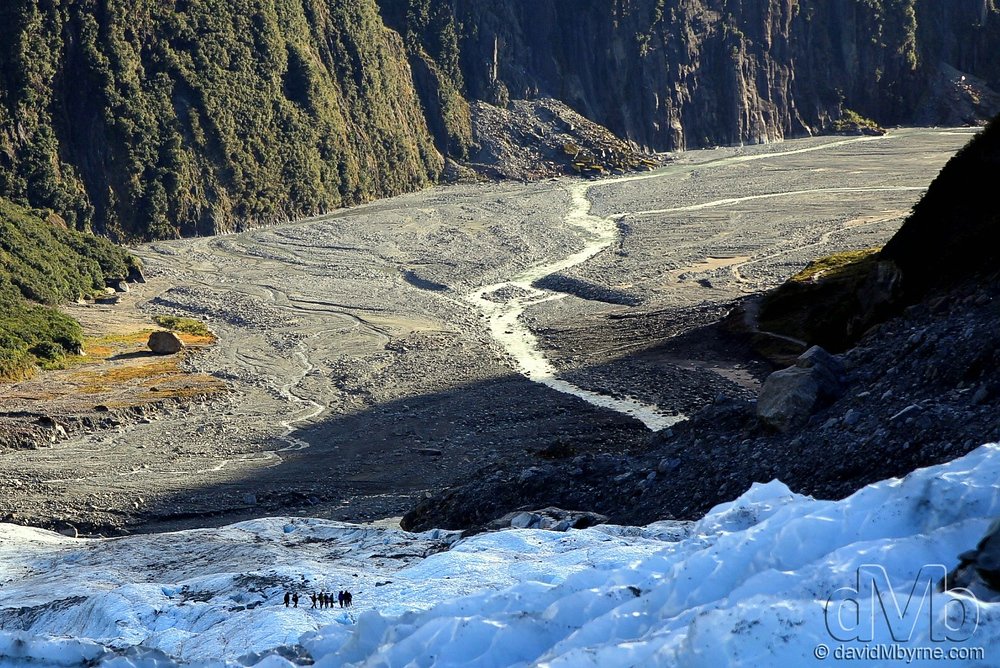
- A party of climbers look very small as they descend Fox Glacier. May 19th 2012.
There are over 3000 glaciers in New Zealand longer than 100m in length & this, Fox Glacier, along with nearby Franz Joseph Glacier, is one of the South Island’s must-see sights. The two glaciers, geographically 23km apart, are unique in that nowhere else in the world at this latitude do glaciers come so close to the ocean.
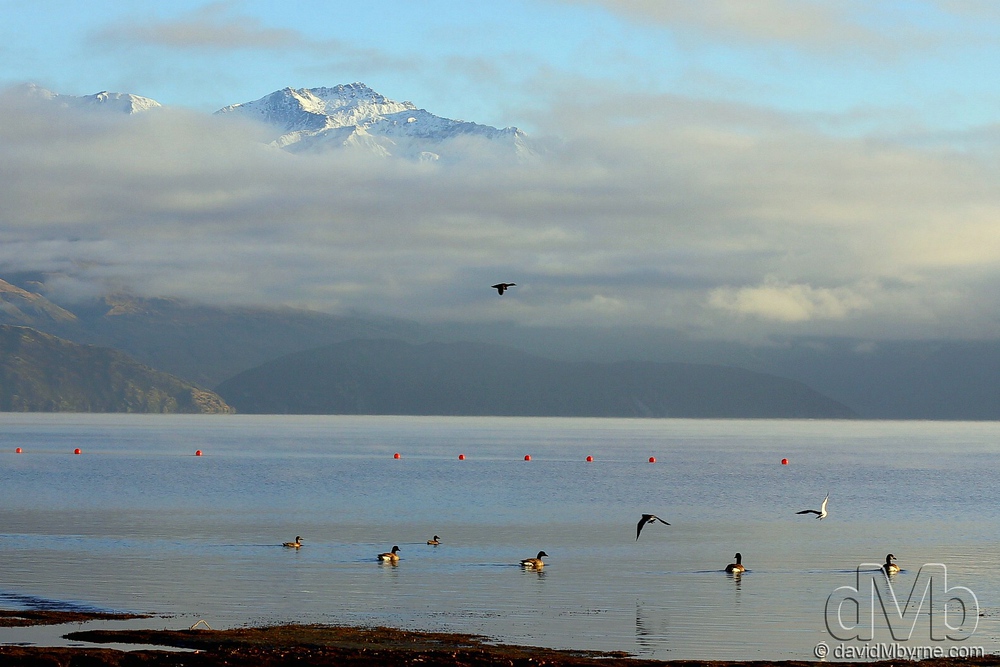
- Early morning at Lake Wanaka. May 21st 2012.
In a country overrun with stunning locations there can be very few as beautiful as Wanaka, a charming lakeside town surrounded by mountains and situated at the southern end of the lake of the same name. This is an early morning picture taken from the shores of the lake looking out towards the Southern Alps which make a stunning backdrop to the town.
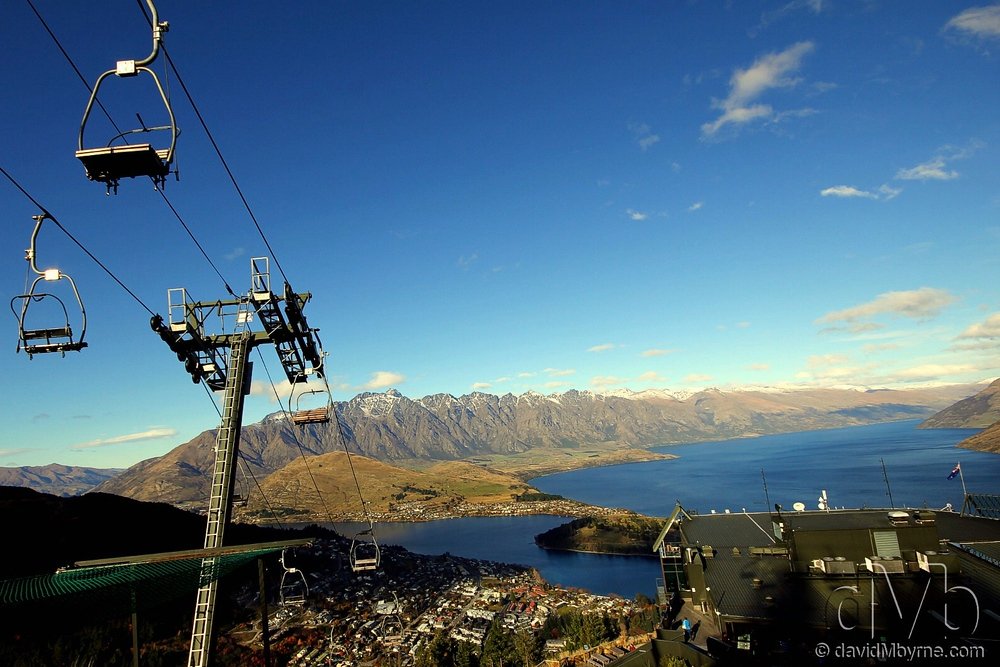
- Queenstown, the adventure/adrenalin capital of the Southern Hemisphere, as seen from Bobs Peak. May 23rd 2012.
Surrounded by majestic mountains & nestled on the shores of crystal clear Lake Wakatipu, Queenstown is another South Island location with a drop-dead gorgeous setting. The so-called adrenalin capital of the Southern Hemisphere (some say the world), it is an immensely popular stop on the travellers circuit, especially in the winter months of July & August when the après ski crew are in town.
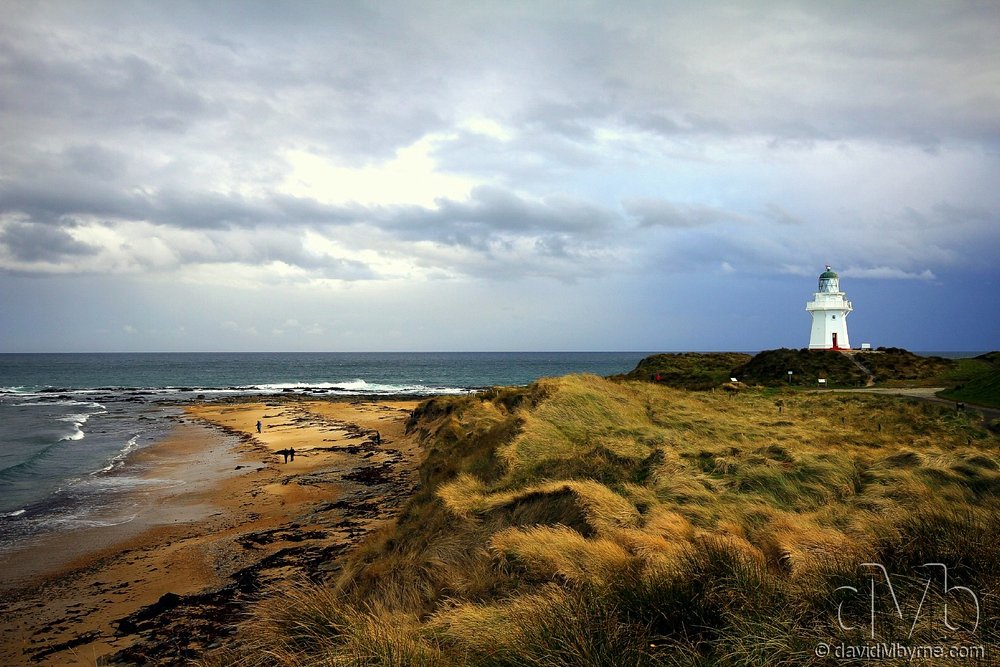
- Exposed Waipapa Point on The Catlins coast. May 27th 2012.
The Catlins, in the extreme south-east of the South Island, is yet another area of untouched costal scenery. Waipapa Point, a rocky promontory not too far from Slope Point, the most southern point on the South Island, is an exposed location infamous for it frequently wild weather, heavy ocean swells & as the scene of New Zealand’s worst maritime disaster – on April 29th 1881 the passenger steamer Tararua, en route to Melbourne, Australia, foundered offshore with the loss of all but 20 of the 151 people aboard. The lighthouse seen here, Waipapa Point Lighthouse, was built in response to the tragedy. It began operating in 1884 & became fully automated in 1976.
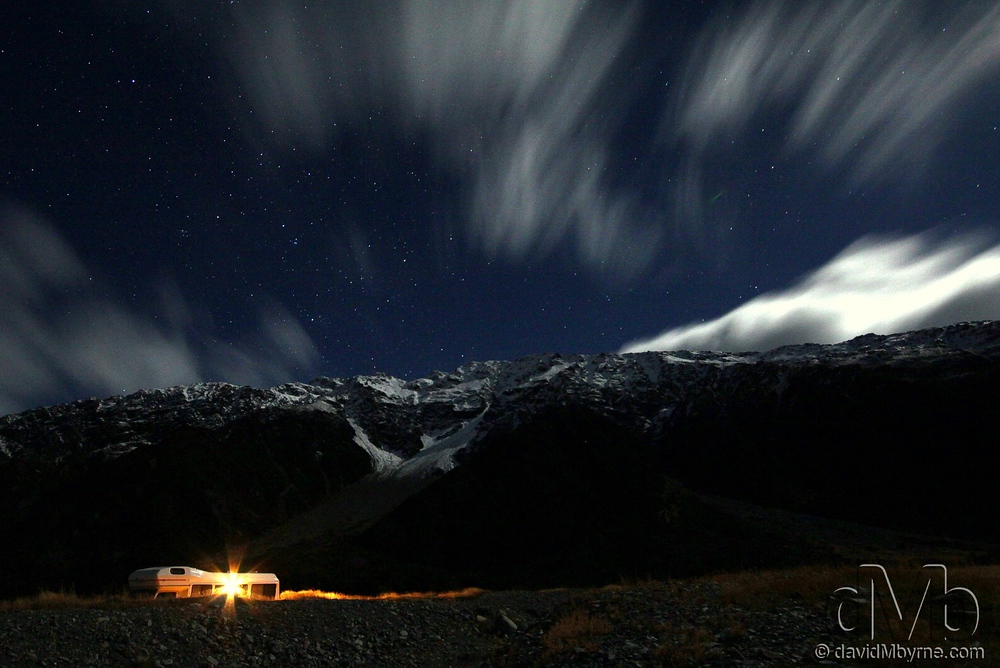
- The snow-capped peaks of Mount Cook National Park. May 30th 2012.
Mount Cook National Park sits in the centre of the New Zealand’s South Island. 22 of the 27 highest peaks in the country are to be found in this area, with the highlight being Mount Cook itself, the highest peak in the country. This is an extended exposure image taken in the White Horse Hill Camp Ground in the shadow of some of the other impressive park peaks, about a 2-hour walk from the glacier lake at the foot of Mount Cook.
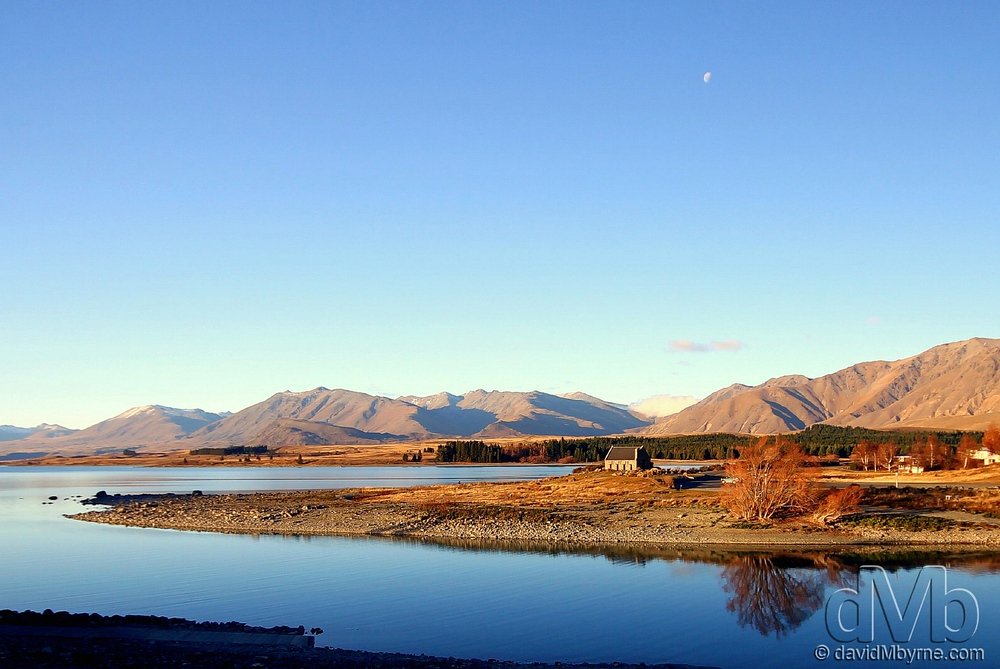
- Sunset at The Church of The Good Shepard on the shores of Lake Tekapo. May 31st 2012.
The expansive inland plains of the South Island, Mackenzie Country, is an area of high ground, clean air, distant mountain ranges & turquoise lakes. Right in the heart of all this is stunningly beautiful Lake Tekapo, on the shores of which you’ll find the iconic Church of the Good Shepherd, arguably one of the most photographed buildings in New Zealand (& for good reason).
Photography Tips For Capturing The Sheer Beauty Of New Zealand
1. Embrace the Golden Hours
The best light for photography in New Zealand comes during the golden hours—shortly after sunrise and just before sunset. The soft, warm light enhances the natural beauty of the landscapes, creating stunning shadows and vibrant colors. Whether you’re capturing the rolling hills of Hobbiton or the jagged peaks of the Southern Alps, shooting during these times will elevate your photos.
- Pro Tip: Plan your shoots around these times to make the most of the natural light. In New Zealand, the sun can rise and set quickly, especially in the mountains, so be ready to capture those fleeting moments.
2. Use a Wide-Angle Lens for Landscapes
New Zealand’s landscapes are vast and breathtaking, making a wide-angle lens an essential tool in your photography kit. This lens allows you to capture the sweeping vistas, dramatic coastlines, and expansive skies that make the country so photogenic.
- Lens Choice: A lens with a focal length between 10-24mm is ideal for capturing the grandeur of locations like Milford Sound or the Tongariro Alpine Crossing. The wide field of view will give your photos a sense of scale and depth.
3. Play with Reflections
New Zealand is famous for its crystal-clear lakes, which offer perfect opportunities for reflection photography. Mirror-like surfaces, such as Lake Matheson or Lake Pukaki, create stunning symmetrical images that are a favorite among photographers.
- Techniques: To enhance reflections, shoot in the early morning when the water is calm. Use a tripod to keep your camera steady and experiment with different angles to capture the best reflections of mountains, skies, and trees.
4. Capture the Night Sky
New Zealand’s remote locations, like Aoraki/Mount Cook and Stewart Island, are perfect for astrophotography. The lack of light pollution makes the stars shine brightly, and on clear nights, you can capture the Milky Way in all its glory.
- Astrophotography Settings: Use a wide-angle lens with a large aperture (f/2.8 or lower) and set a high ISO (1600-3200) to capture the faint light of the stars. A long exposure of 15-30 seconds will bring out the details in the night sky.
5. Focus on the Details
While New Zealand’s landscapes are awe-inspiring, don’t forget to focus on the smaller details that make the country unique. Macro photography can capture the intricate beauty of native flora, such as ferns and moss, or the textures of volcanic rocks.
- Close-Up Shots: Use a macro lens or a telephoto lens with a short focal length to capture close-ups. This technique is particularly effective in the rainforests of Fiordland or the geothermal areas around Rotorua.
6. Experiment with Composition
New Zealand’s diverse landscapes provide endless opportunities to experiment with composition. Use leading lines, such as roads or rivers, to draw the viewer’s eye into the scene. Frame your shots using natural elements like trees or rocks to add depth and interest.
- Rule of Thirds: Apply the rule of thirds to create balanced and dynamic compositions. Place key elements, like a mountain peak or a tree, off-center to create a more visually engaging image.
7. Capture the Changing Weather
New Zealand’s weather can be unpredictable, but this offers a unique opportunity to capture dramatic scenes. Mist, rain, and clouds can add mood and atmosphere to your photos, transforming a simple landscape into something extraordinary.
- Weather Photography: Don’t shy away from shooting in less-than-ideal conditions. Stormy skies over the West Coast or a misty morning in Fiordland can result in powerful, moody images that tell a story.
8. Utilize Long Exposures for Waterfalls and Rivers
New Zealand is dotted with stunning waterfalls and rivers, from the mighty Huka Falls to the serene rivers of the South Island. Use long exposure settings to capture the smooth, silky motion of the water.
- Settings: Set your camera to a low ISO and use a small aperture (f/16 or higher). A shutter speed of 1-2 seconds will create the desired effect. Use a tripod to avoid camera shake.
9. Leverage Polarizing Filters for Enhanced Colors
A polarizing filter is essential when shooting landscapes in New Zealand. It reduces reflections from water and enhances the colors of the sky and foliage, making your images pop.
- Best Use: When shooting lakes, rivers, or coastal scenes, a polarizer will help you capture deeper blues in the sky and more vibrant greens in the vegetation.
10. Capture the Majesty of Fiordland
Fiordland, home to Milford and Doubtful Sounds, offers some of the most dramatic landscapes in New Zealand. The sheer cliffs, dense forests, and waterfalls cascading into deep fiords make for breathtaking photos.
- Approach: Use a wide-angle lens to capture the vastness of the landscape. Early morning or late afternoon light is best for emphasizing the depth and scale of the fiords.
11. Photograph the Unique Geothermal Areas
Rotorua and Taupo are known for their geothermal activity, featuring geysers, hot springs, and bubbling mud pools. These unique landscapes offer vibrant colors and surreal scenes that are perfect for photography.
- Composition Tips: Focus on the contrasting colors—bright oranges, reds, and blues of the geothermal features against the lush greenery. A wide-angle lens will help capture the full scope of these areas.
12. Capture the Seasonal Changes
New Zealand’s beauty is ever-changing with the seasons. In autumn, the Central Otago region comes alive with golden foliage, while winter transforms the Southern Alps into a snow-covered wonderland.
- Seasonal Strategy: Plan your visit according to the season you wish to capture. Autumn is ideal for vibrant colors, while winter offers dramatic snow-covered peaks and clear skies.
13. Explore New Zealand’s Iconic Coastlines
The country’s rugged coastlines, such as those along the West Coast and the Catlins, provide stunning photo opportunities. Rocky cliffs, sea stacks, and crashing waves create dynamic scenes.
- Seascape Techniques: Use a slower shutter speed to capture the movement of the waves against the rocks, creating a sense of motion. Golden hour is the best time for capturing warm light on the coast.
14. Incorporate People or Wildlife in Your Shots
Adding a person or an animal into your landscape shots can provide scale and a focal point, making your images more engaging. Whether it’s a hiker on a trail or a native bird like the kea, these elements bring your photos to life.
- Composition: Place the person or animal using the rule of thirds to draw the viewer’s eye and add a sense of scale to the vast landscapes.
15. Take Advantage of New Zealand’s Dramatic Weather
New Zealand’s weather is known for being unpredictable, but this can work to your advantage. Storm clouds, rainbows, and changing light conditions add drama and mood to your landscape photos.
- Weather Shooting: Don’t be afraid to shoot in stormy weather. Use the dramatic skies and shifting light to create powerful, atmospheric images. A waterproof camera cover is a good investment for these conditions.
Turning New Zealand’s Scenery and Photo Essay Inspiration Into A Real Trip
Looking at those beaches, glaciers and star-filled skies, it’s easy to think, “Okay, but how do I actually do this as a trip?”
New Zealand is one of those places that rewards a bit of planning. Distances are longer than they look on the map, the weather likes to keep you guessing, and there’s always one more lake / summit / cove tempting you to reshuffle your plans.
Let’s turn all that scenery from the photo essay into something you can actually build an itinerary around: where to go, how long to stay, what things cost, and how to string the North and South Islands together without spending the whole time behind a windshield.
North Island vs South Island: Where To Spend Your Days
You can have an amazing trip on either island. You don’t have to do it all in one go. But if you’re trying to divide your time, this is how they shake out at a glance:
| Island | Vibe & Landscape | Signature Highlights | Best For |
|---|---|---|---|
| North Island | Warmer, geothermal, beaches, rolling hills | Northland coast, Rotorua, Tongariro, culture, cities | First-timers who like variety in a short time |
| South Island | Bigger, wilder, “wow” mountains and glaciers | West Coast, Fox/Franz, Wanaka, Queenstown, Mt Cook, Catlins | Hikers, road-trippers, scenery hunters |
A simple rule if you’re doing both:
- 10 days total → 3–4 days North, 6–7 days South
- 14 days total → 5–6 days North, 8–9 days South
- 3 weeks → Roughly split in half and move slower
If your heart is set on glaciers, alpine lakes and moody coastlines like the Catlins, lean South. If you’re more pulled to geothermal craziness, Maori culture and subtropical beaches up around Cape Reinga, give more weight to the North.
Classic Scenic Routes & Easy-To-Follow Itineraries
10–14 Days: “Greatest Hits” North + South
This is the kind of trip that lets you move from golden beaches and geothermal pools to glaciers and big mountains without feeling rushed every single day.
Days 1–3: Auckland & Northland Taster
- Base in Auckland or nearby and steal at least a full day out to the coast.
- If you’ve got wheels and the energy:
- Explore Tawharanui Regional Park for those quiet beaches and rolling headlands.
- Overnight in Matakana / Warkworth or push further north towards Bay of Islands if you’re keen.
- With an extra day, a long haul up towards Cape Reinga turns the “end-of-the-world” photo into a full experience—sand dunes, empty beaches, and those two oceans meeting.
Days 4–5: Rotorua & Surroundings
Head down to Rotorua for steaming vents, boiling mud, and that sulphur-in-the-air smell that tells you you’re in the right place.
- Visit a geothermal park (Hell’s Gate, Wai-O-Tapu, etc.).
- Add in a Maori cultural evening if that’s your thing.
- Day trip to Lake Rotorua, nearby forests, or pair it with nearby Taupo to get views across the lake to volcanic peaks on a clear day.
Days 6–7: Tongariro & Central Plateau
Base yourself in National Park Village or Turangi.
- If you’re hiking-fit and the weather plays nice, the Tongariro Alpine Crossing is one of the most spectacular day hikes you’ll ever do.
- If conditions aren’t right, there are plenty of shorter walks with crater, lake and volcano views that don’t require an epic slog.
Days 8–10+: Fly South & Chase Mountains
Fly or ferry your way to the South Island, then:
- Aim for Wanaka if you want sunrise lake views and relaxed walks.
- Continue to Queenstown for the bigger adrenaline hit and that famous view from Bob’s Peak.
- If you’ve got a few more nights:
- Add a loop out to the West Coast for Fox or Franz Josef Glacier.
- Or head inland to Mt Cook National Park and Lake Tekapo for those snow-capped peaks and night skies.
A 14-day version just pads this out, giving you extra nights in Rotorua/Taupo and Wanaka/Queenstown so you’re not doing one-night stands with every town.
3 Weeks: A Scenic Road Trip That Breathes
If you’ve got three weeks, you can afford to move at a human pace, repeat your favourite walks, and build in “do nothing” days that still somehow end with ridiculous sunset photos.
North Island (7–9 Days)
Northland Loop (2–3 days)
- Day 1: Auckland → Tawharanui or the east coast beaches
- Day 2: Push north towards Bay of Islands or further to Cape Reinga
- Day 3: Work your way back down a different route, dipping into beaches and kauri forests
Rotorua / Taupo (2–3 days)
- Mix geothermal parks, lakeside walks, short forest tracks and hot pools.
- Save one evening for soaking under the stars if the sky behaves.
Tongariro area (2–3 days)
- One full flexible day earmarked for the Tongariro Crossing. If the weather closes in, swap in shorter walks or just sit and watch the peaks shift under changing cloud.
South Island (12–14 Days)
West Coast & Glaciers (3–4 days)
- Christchurch or Nelson → West Coast.
- Follow the coast south, stopping for rainforest trails, wild beaches and those vast ocean views.
- Spend a couple of nights around Fox / Franz Josef:
- One day for a glacier walk / scenic flight if it’s in the budget.
- Another for forest and lake walks—Lake Matheson is a classic reflection spot.
Wanaka & Queenstown (4–5 days)
- Split your time between both towns or base in one and day-trip.
- Wanaka for chilled lakeside walks and “I could live here” vibes.
- Queenstown for gondola views, jet-boating, and all the high-energy stuff.
Catlins & Deep South (2–3 days)
- Loop down through the Catlins for lighthouses, sea cliffs, and long empty stretches of coast like Waipapa Point.
- Ration your photo stops—this area is one long temptation to pull over every five minutes.
Mount Cook & Tekapo (3 days)
- Drive into Aoraki/Mt Cook National Park and give yourself at least two nights if you can.
- Walk up the Hooker Valley Track for that “glacier lake + giant peaks” combo.
- Finish at Lake Tekapo with the Church of the Good Shepherd at either sunrise or sunset, then turn your lens straight up after dark.
Getting Around: Car, Campervan or Bus?
New Zealand and road trips go hand in hand. Having your own wheels is the easiest way to hit trailheads, small coves and those slightly-off-route viewpoints.
Quick Comparison
| Option | Pros | Cons | Best For |
|---|---|---|---|
| Car | Flexible, good for shorter trips, easier in towns | Need paid beds each night, less “camp life” experience | Couples, friends, light packers |
| Campervan | Your bed travels with you, epic freedom, scenic camps | More expensive, slower, parking in cities can be a pain | Longer trips, outdoorsy travellers |
| Bus Pass | No driving stress, good for solo travellers on budget | Fixed routes/times, harder to reach remote photo spots | Backpackers, non-drivers |
Whichever you choose, keep in mind:
- Distances look short but roads are twisty, hilly and often single-lane each way. A “3-hour” drive can easily become 4+ with scenic stops.
- Don’t stack long driving days back-to-back. Alternate them with days where the car barely moves.
- The most memorable shots often come from unplanned pull-outs—give yourself time for those.
Scenic Bases: Where To Wake Up To A View
You don’t have to sleep somewhere spectacular every single night, but choosing a few “wow” bases makes a big difference.
North Island Bases
Northland
- Paihia / Russell if you want boat trips and island views.
- Somewhere near Tawharanui or Matakana if you’re chasing quieter bays and sunset beaches.
- If Cape Reinga is on your radar, aim for a night up around Kaitaia or further to break the drive.
Rotorua / Taupo
- Rotorua gives you that geothermal-city feel and easy access to parks.
- Taupo feels a bit more laidback, with lakefront views and mountain silhouettes on the horizon in good weather.
Tongariro Area
- National Park Village is small but close to trailheads.
- Turangi works if you want a larger supermarket and more services.
South Island Bases
West Coast & Glaciers
- Punakaiki or Hokitika for blowholes, driftwood beaches and moody sea light.
- Fox Glacier if you’re keen on both glacier activities and Lake Matheson reflections at sunrise or sunset.
Wanaka
- A solid base for lakefront sunrises, nearby hikes and that “I might never leave” feeling.
- Good if you want scenery without the full-on Queenstown party vibe.
Queenstown
- Best if you want to mix scenery with activities: gondola views, bungee, rafting, day-tours into the surrounding region.
- Book ahead in peak seasons; it fills up fast.
Mount Cook & Tekapo
- Mount Cook Village feels like you’re sleeping inside the mountains.
- Tekapo is all about that turquoise lake and the night sky—choose at least one night where you’re willing to stay up late with a tripod.
Budgeting A Scenery-Focused Trip
New Zealand isn’t a super-cheap destination, but a lot of the best scenery is technically free: beaches, tracks, coastlines and viewpoints.
Here’s a rough daily cost per person (in NZD) if you’re sharing some costs like rooms and car hire:
| Style | Bed | Food & Drink | Transport/Activities | Daily Total (approx) |
|---|---|---|---|---|
| Budget | Dorm / basic | Self-cater + cheap eats | Bus / shared car, mostly free hikes | 80–120 |
| Flashpacker | Simple double | Mix of self-cater & cafes | Rental car + occasional paid activity | 130–200 |
| Mid-Range | Nice motel / lodge | Restaurants most days | Car + a couple of bigger-ticket tours | 200–300+ |
A couple of big line items that move the needle:
- Glacier heli-hike or scenic flights – incredible, but they will chew through a chunk of your budget.
- Multiple paid geothermal parks – choose one or two good ones rather than ticking them all.
- Extra ferry or flight crossings – doing both islands in and out can add up.
You can bring things down by:
- Mixing supermarket lunches with the odd meal out.
- Using DOC campsites or basic huts if you’re set up for it.
- Building your trip around mostly free walks and scenic drives, then sprinkling in one or two paid “wow” experiences that matter most to you.
Best Time To Visit For Landscapes & Photos
New Zealand never really has a bad season, but each one shifts the mood of your photos and your trip.
| Season | Months (roughly) | Pros | Cons | Best For |
|---|---|---|---|---|
| Summer | Dec–Feb | Long days, warm temps, great for beaches & hiking | Busy, higher prices, popular spots can feel crowded | First-timers, families, beach days |
| Autumn | Mar–May | Golden colours in Central Otago, fewer crowds | Cooler nights, some alpine areas start seeing snow | Photographers, road trippers, calmer vibe |
| Winter | Jun–Aug | Snowy peaks, ski season, crisp air, clear night skies | Cold in the south, some hikes and roads affected by snow/ice | Skiers, Mt Cook/Tekapo night-sky hunters |
| Spring | Sep–Nov | Wildflowers, waterfalls in full flow, shoulder-season prices | Weather can swing wildly in one day | Hikers who don’t mind mixed conditions |
If your priority is big mountain scenery and astrophotography, I’d be tempted by late autumn or winter: fewer people, great sky conditions, and snow-dusted peaks.
If you want warmer road-tripping and beach time around Northland or the Catlins, aim for late spring or early autumn to dodge the heaviest crowds and highest prices of peak summer.
Practical Tips & Easy Mistakes To Avoid
Don’t Try To Do Both Islands In A Week
Technically possible. Emotionally exhausting. You’ll spend your days driving and your evenings looking at photos of places you barely saw. If all you have is 7 days, pick one island and give it your full attention.
Build Weather Flexibility Into Your Plan
That Tongariro hike, that glacier flight, that night-sky mission at Tekapo—these all live or die by the weather.
- Always schedule at least one backup day near big-ticket outdoor experiences.
- Swap your days around on the fly if the forecast shifts in your favour.
Watch Your Driving Days
The temptation is to connect every dot: Cape Reinga to Rotorua to Tongariro to Wellington to Abel Tasman to West Coast to Queenstown…
Instead:
- Prioritise 2–3 anchor regions and explore more deeply.
- Cap most driving days around 3–4 hours max and aim to stop early enough to catch golden hour somewhere interesting.
Respect The Conditions On Trails & Roads
New Zealand has a way of humbling overconfidence—on both the hiking trails and the highways.
- Check local advice and track conditions, especially in alpine areas.
- In winter, consider whether you need chains or to skip certain routes entirely.
- If DOC signs say a trail takes 6 hours, don’t assume you can smash it out in 3.
Give Yourself Permission To Just Sit And Stare
Some of the best moments aren’t on the “must do” list:
- Watching clouds shift over a lake from the same bench for an hour.
- Sitting outside a campervan with a cup of something hot while the last light leaves a valley.
- Listening to waves hammer the Catlins coast without feeling the need to capture every second.
The photos will come, but the trip feels much richer when you leave space for the in-between.
New Zealand North & South Island Scenery: Key Questions, Honest Answers & Practical Tips
How long do I realistically need to capture the kind of New Zealand scenery shown in this photo essay?
Honestly, two weeks is the sweet spot if you want to see both islands without feeling like you’re in a car-commercial marathon. That gives you time for a Northland taster, Rotorua/Tongariro, and a solid loop through glaciers, lakes, and mountains in the south.
If you’ve got 10 days, you can still hit a “greatest hits” route, but you’ll be trimming side trips and hanging around less when the light is perfect. Three weeks is where things get really fun: slower mornings, repeat visits to favourite spots, and room for extra detours like the Catlins or Fiordland without sacrificing sleep.
If all you have is one week, I’d pick just one island and go deep instead of trying to zigzag the whole country.
When is the best season to visit New Zealand for landscapes and photography on both islands?
It depends. For pure scenery and photography, shoulder seasons usually beat peak summer.
Autumn (March–May) is gorgeous around Central Otago and Wanaka, with golden trees and calmer roads. Winter (June–August) is magic for snow-capped peaks and crisp night skies in places like Tekapo and Mt Cook, though you’ll need to be prepared for cold and the odd road or trail closure.
Summer (December–February) gives you long days, warm temperatures, and lots of hiking options, but it also means more people and higher prices in Queenstown, Wanaka, and popular coastal areas. Spring (September–November) is a bit of a wild card with changeable weather, but waterfalls are pumping and everything feels fresh and green.
Is it worth visiting both North and South Island on my first trip, or should I focus on one?
Absolutely. If you’ve got 14–21 days, doing both islands gives you a great contrast: subtropical beaches and geothermal madness up north, huge mountains and glaciers down south.
If you’re working with 7–10 days, I’d seriously consider picking one island and doing it justice. The South Island wins for big, dramatic landscapes in a compact area. The North Island wins if you’re more into geothermal areas, Maori culture, and a mix of cities and coast.
Think about what you’re most excited by from the photo essay—Cape Reinga and Rotorua, or Wanaka, Queenstown and Mount Cook—and let that decide your focus.
Do I really need to rent a car or campervan, or can I rely on buses and tours to reach these spots?
Nope, a car or campervan isn’t absolutely mandatory, but it makes a big difference for this kind of scenery-focused trip. Many of the photo-worthy detours—quiet bays in Northland, random West Coast viewpoints, sunset spots around Tekapo—are far easier with your own wheels.
You can still do a good trip using intercity buses and organised day tours from hubs like Auckland, Rotorua, Queenstown and Wanaka. It just means you’ll be working around timetables and might miss some of the quieter lay-bys and roadside scenes that make New Zealand such a fun place to wander.
If you’re nervous about driving, you could mix it: start with a few guided trips, then rent a car for a shorter leg when you’ve adjusted to the roads.
Is driving in New Zealand safe for visitors who aren’t used to left-hand traffic?
Mostly, yes. But you need to respect the roads. New Zealand driving is less about speed and more about staying alert on narrow, winding highways with lots of bridges, hills and curves.
The big adjustments are driving on the left, roundabouts, and judging distances on twisty roads. Take your time at first, avoid long drives on your arrival day, and don’t plan back-to-back epic stretches. If you’re feeling tired or jet-lagged, call it an early day and enjoy the sunset instead of pushing on in the dark.
If you’re comfortable with road trips at home and you keep your ego in check, you’ll be fine.
How much should I budget per day for a scenery-focused New Zealand trip?
Ballpark? Think of New Zealand as a mid- to high-cost destination, especially once you factor in accommodation and transport.
For a shoestring trip sharing rooms, cooking a lot, and mostly doing free hikes, you might land somewhere in the budget range—simple hostels or campsites and the odd pub meal. Mid-range travellers in private rooms, eating out once or twice a day and renting a car will sit higher. Add in glacier flights, organised tours, or lots of restaurant meals and the daily number climbs quickly.
The good news is that most of the scenery—beaches, lakes, trails, mountain viewpoints—is free. If you build your trip around walks and road-trip views and then sprinkle in just one or two big-ticket experiences, you can keep costs under better control.
Where are the best places to base myself on the South Island for landscapes like in the photos?
If you’re chasing the exact kind of scenery in the photo essay, you can’t go wrong with a simple base “circuit”: West Coast, Wanaka/Queenstown, and the Mt Cook–Tekapo area.
Stay along the West Coast (Hokitika, Franz Josef, or Fox Glacier) for that wild coastline and glacier access. Wanaka is brilliant if you want lakefront sunrises, laid-back cafes and day hikes. Queenstown is ideal when you want scenery plus all the classic activities and day tours.
Round things out with at least one night in Mt Cook Village and one in Tekapo if you’re keen on big peaks and starry skies. All of these spots make it easy to wake up, step outside, and feel like you’ve just walked into a landscape shot.
Are the famous hikes and lookouts like Tongariro and Mt Cook suitable for beginners?
Not really, if we’re talking about the full-on Tongariro Alpine Crossing in rough weather. That’s a serious day hike with changeable conditions, and it’s not the place to discover you hate steep climbs or wind. With good fitness, decent gear and a favourable forecast, it’s doable for keen beginners, but you still need to treat it with respect.
The good news is that there are plenty of more forgiving options with great views. Around Tongariro National Park you’ll find shorter crater and waterfall walks. In Mt Cook National Park, something like the Hooker Valley Track gives you a big “glacier lake plus mountain backdrop” moment on a well-formed path.
If in doubt, chat to local visitor centres (i-SITE or DOC) about trail conditions and pick the option that suits your fitness and the day’s weather.
What should I pack for a New Zealand trip that involves a lot of outdoor time and photography?
Layers. Always layers. New Zealand loves throwing you three seasons in a day, especially in the mountains and along the West Coast. A simple packing framework is:
- A lightweight waterproof jacket
- A warm mid-layer (fleece or puffy)
- Comfortable quick-dry hiking clothes
- A beanie and gloves if you’re travelling outside summer
- Sturdy walking shoes or boots with decent grip
For photography, a small tripod is gold for sunrise, sunset and night-sky shots, and a rain cover or dry bag for your camera is worth its weight in stress relief. Add sunscreen, sunglasses and insect repellent to your daypack and you’re in good shape for most situations.
How bad are sandflies really on the West Coast and in the Catlins, and how do I cope?
Annoying. That’s the honest answer. In some West Coast spots, Fiordland and parts of the Catlins, sandflies can be relentless when the air is still. They don’t ruin the trip, but they can definitely ruin a peaceful photo session if you’re not prepared.
Long, light trousers and sleeves, plus liberal use of repellent, go a long way. Try to keep moving if they’re particularly vicious in one area, and avoid lingering barefoot on damp, windless riverbanks and lakeshores. Most people adapt pretty quickly—take a few precautions, laugh about it, and don’t let the little monsters chase you back into the car too soon.
Is New Zealand a good destination for solo travellers who love landscapes and photography?
Yes. New Zealand is one of the easier countries in the world to travel solo, especially if you’re into the outdoors. It’s safe by global standards, English is widely spoken, and there’s a strong hostel and campervan culture, which makes it simple to meet people on hikes, in shared kitchens, or on organised trips.
If you’re introverted, the scenery itself keeps you company—long drives, quiet lookouts, and solo photo missions feel pretty natural rather than lonely. If you’re social, booking the odd group hike or activity in places like Queenstown, Rotorua or Wanaka will fill your days with new faces quickly.
Can I do this kind of New Zealand road trip with kids or as a family?
Absolutely. New Zealand is very family-friendly, and a lot of the scenery is easy to access without epic hikes. Short trails to lookouts, lakeside promenades, safe swimming spots, and simple walks through forests or to lighthouses work well with kids of different ages.
Campervans are popular with families because your “home” comes with you and you don’t have to unpack every night. The trade-off is that you’ll be moving more slowly and planning more frequent rest stops and playground breaks, which honestly isn’t a bad thing in a country that rewards slow travel.
Just build in shorter driving days, mix “wow” hikes with easy downtime by the lake or beach, and always have snacks ready for both kids and grown-ups.
Do I need to book accommodation and activities in advance, especially in popular scenic areas?
Often, yes. In peak periods—summer holidays, school breaks, and ski season—places like Queenstown, Wanaka, Tekapo, and Mt Cook Village can book out or become eye-wateringly expensive if you leave it too late.
For a scenery-focused trip, I’d lock in at least the key bases and any must-do activities (like glacier flights or certain tours) ahead of time. In shoulder seasons you can play things a bit looser, but it’s still wise to reserve weekends and popular spots a few weeks out.
If you’re travelling by campervan, remember that some holiday parks and popular DOC campsites also fill up early in busy periods. A little forward planning saves a lot of stress.
Are there any cultural or environmental etiquette tips I should follow in New Zealand’s wild places?
Definitely. New Zealanders are generally relaxed, but there’s a deep respect for nature and for Maori culture that visitors are expected to share.
In natural areas, stick to marked trails, pack out your rubbish, and avoid feeding wildlife. If a place feels special or sacred—like certain headlands, forests, or sites with carvings and meeting houses—take a moment to read any signs, follow guidance about where you can walk, and dress and behave respectfully.
A simple rule is: leave things as you found them, or slightly better, and remember that a lot of the landscapes you’re photographing are treasured places for the people who live there.
Can I see the night sky and Milky Way easily, or do I need to book a special stargazing tour?
Nope, you don’t have to book a tour to enjoy the night sky, but tours can add nice context and gear you might not have. Many places in New Zealand, especially smaller towns and national parks, have low light pollution, so just stepping outside on a clear night can be jaw-dropping.
The Tekapo and Mount Cook area is particularly famous for dark skies, but you’ll also get great stars around quiet lakes, coastal spots, and rural campsites. If you’re into photography, a tripod and a bit of patience will go a long way. Tours are helpful if you want telescopes, expert guidance and a guaranteed “no-guesswork” experience.
What are some underrated scenic stops between the big-name places that are worth pulling over for?
Plenty. One of the joys of New Zealand is that a random lay-by can be just as beautiful as the famous viewpoint you were aiming for.
On the North Island, the quieter bays and regional parks around Northland, small forest walks near Rotorua, or roadside lakes on the way to Tongariro often surprise people. On the South Island, short detours to lakes just off the main highway, lesser-known West Coast beaches, or viewpoints along the road into Mt Cook can be as photogenic as the “headline” spots.
If a side road looks promising and you’ve got daylight and fuel, follow your nose. Some of your favourite photos may end up coming from those unscripted five-minute stops.
Bio/About the Author
David M is a hobbyist photographer, Getty Images Artist & ardent traveller. His photography blog contains an ever-growing collection of quality images captured all over the world. You can also find him on facebook, twitter, Google+ & flickr.
- Travel with davidMbyrne.com: http://Travel.davidMbyrne.com/
- Facebook: http://www.facebook.com/pages/davidMbyrnecom/130866190344477
- Twitter: https://x.com/ByrneDavidM/
- Google+: https://plus.google.com/u/0/103392590710794468694/
- flickr: http://www.flickr.com/photos/davidmbyrne/



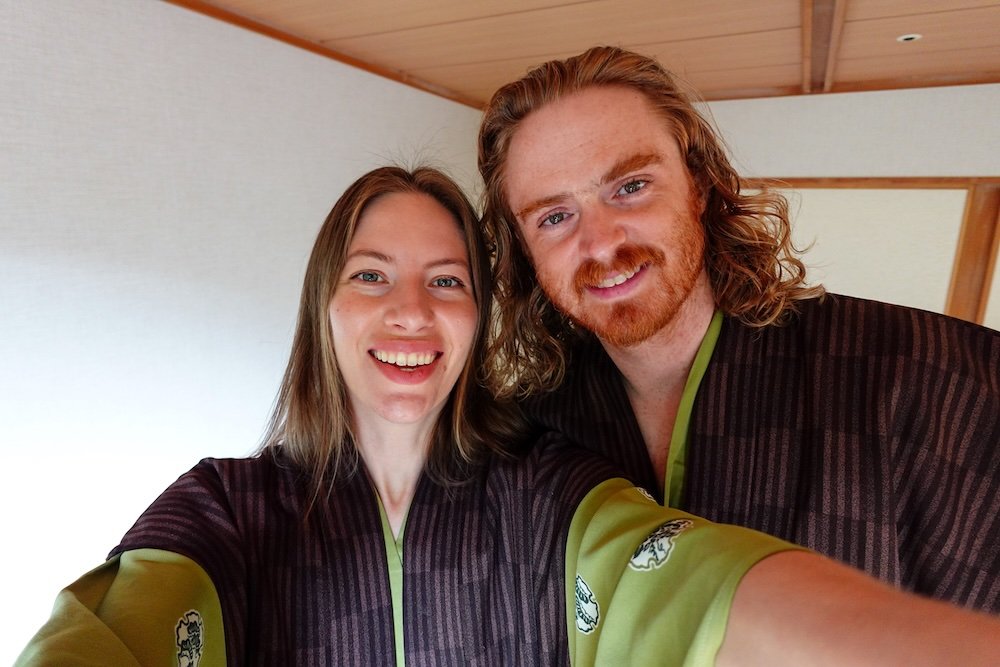
Your pictures have me so excited for my upcoming move to New Zealand. I have no idea what I’m going to do there except wander around, look at awesome nature sh*t and write about it.
I have to agree, the photos you took are stunning! Love the ski fields in NZ. Can’t wait to hit the slopes soon!
Incredible photos! We did a 2 week road trip around both islands and had the time of our lives. Some of the scenery is unbelievable there.
Love Queenstown – Love New Zealand!
Love Skiing in NZ
A nice shot of The Church of The Good Shepard at the end. This view of the Lake Tekapo is still one of the brightest memories of my first visit to New Zealand South Island.
I am speechless and off to check David’s blog.
Gorgeous photos, I particularly love the long exposure night shot with the camper and the moving clouds. New Zealand tops my wish list after crossing Patagonia off in 2012. Had perfect weather for the full circuit at Torres Del Paine in Chilean Patagonia and snagged some of the best shots of my life. Keep it up man!
Wow – NZ has always been stunning, but these shots have nailed her beauty! Gorgeous. Makes me really want to dive right in to another southern hemisphere adventure!
Ah my beautiful country:) Tongariro is beautiful isn’t it.
What stunning photos! I love the variety in the subjects – but also the weather conditions and times of day. New Zealand really is beautiful all the time, isn’t it?
Thanks 🙂 It’s certainly inspired me to go – hopefully rather than later.
Wow Samuel this pictures are absolutely great! Love them
Thanks Anita, I’ll be sure to pass that on to David.
That is one really massive tree. Neat.
I think we saw the same ducks at Wanaka.
That is so cool you found a silver fern. I looked everywhere we went and though I saw plenty of ferns, I didn’t find such a nice pictures. I think I saw the plant, but it didn’t look so silvery to me.
The ducks at Wanka seem really interesting.
These are great images – well done!
Thanks Cam, I’m impressed with David’s photography.
The Great Firewall of China has finally let me see this. Yahoo. Thanks for posting my very first guest posting Sam! & thanks for all the positive comments on my photography. It’s very gratifying. NZ truly is a unique world destination. Pack a camera… and plenty of money – it’s not cheap location but believe me it’s worth every cent!
Thanks for contributing a great guest post David! You’ve certainly inspired me and a lot of others to go to NZ sooner rather than later.
Stunning images specially the beaches and natural views are awesome. Right place to travel although a long journey.
I have a feeling it’s a country best explored slowly.
NZ certainly has no lack of pretty scenery! Breathtaking photos!!!
It sure is gorgeous.
Stunning pictures! New Zealand was always high on our list of places we must see…but now it’s been bumped even further up the list 🙂 Cheers.
Feel the exact same way Nick! It’s moving on up on my list too.
Stunning photographs! I’ve not yet been to NZ, but certainly intend to visit in the next 2 years as research for my chocolate travel book. I’ve never heard anything bad about this lovely destination. Thx for the visuals to entice us.
That sounds like a fascinatingl project Doreen. I’m guessing the chocolate is just as wonderful as the scenery.
Stunning views and beautiful photography! It’s funny how you said there are 10 times more sheep than people in New Zealand.
10 times more sheep certainly paints a very rural scene.
Everytime I see photos of New Zealand I remind myself that the country must be added to my list of 50+ visited destinations. I know my time will come soon enough. Can picture myself now taking a stroll along The Catlins coast whilst admiring the stunning landscapes surrounding me.
It’s moving higher up my list as well Addison. Hopefully we’ll both get to visit sometime soon!
Such a diverse and wonderful scenery, great pictures!
Thanks Angela!
I’m really impressed with David’s photos.
Stunning photos – can’t wait to visit one day!!
Duncan
Thanks Duncan! I’m looking forward to visiting for the first time.
Amazing photos….. totally jealous! I need to go back to NZ now that I have a better camera….
Most definitely! I need to go for the first time 🙂
Gorgeous photos of one of my favourite countries in the world. Love the angled West Coast in the rain shot in particular 🙂
I’m really looking forward to visiting NZ and Australia after seeing yours and David’s photos 🙂
Wow! David got a great set of pics! I can see why Lord of the Rings was pictured there.
Night sky shot is my favorite.
It was the perfect location for Lord of the Rings. To be honest I never realized how beautiful NZ was until I watched the Trilogy.
Mountains, volcanoes, glaciers – these photos reveal the unique and diverse topography of New Zealand perfectly! I really must experience it for myself NOW!
Thanks Shing, I feel the exact same way. I can’t wait to go there soon.
I adore New Zealand! Great fun looking at your photos. I haven’t been since 2004, and I’m so excited to be taking my husband with me on a return trip in…ten days : )
Wow! You must be incredibly excited 🙂 Best of wishes to you both.
Stunning indeed!! NZ is such a beautiful country with amazing landscapes!! Well captured.
I certainly agree with you Arti. The rugged scenery looks gorgeous.
Stunning indeed!! NZ is such a beautiful country with amazing landscapes. Well captured.
I love the photos. They look amazing, taken from different perspective. My favourite is #9- the wow factor at Lake Haweh- stunning scenery. New Zealand is obviously on my bucket list, not sure when I’ll visit it though, but I’m sure it’s worth seeing.
I’m in the same position as you Agness. I really want to go but I’m not sure when I’ll get a chance.
The humanist in me always seems to want to see people in landscape photos, even if just for scale purposes. hmmm
Stunning photos. New Zealand is easily one the most breathtaking places in the world. Its up there with Turkey in the places I’ve personally witnessed.
Both Turkey and New Zealand are countries I’m dying to visit hopefully as soon as next year 🙂
Fantastic Photography…great descriptions… loved it 🙂
Thanks! I’m certainly more inspired to visit NZ soon 🙂